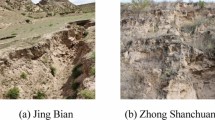Abstract
Marl as a calcareous soil has heterogeneous nature in terms of structure and properties. Any change in the water content of marl can cause significant strength loss; therefore, prior stabilization while constructing civil infrastructures is necessary. A fundamental element in soil stabilization is the relationship between soil structure and stabilizers, but this important factor has been ignored in the available literature, especially in the case of marl soil. Lately, alternative environmentally friendly additives (natural pozzolans) as well as traditional chemical stabilizers (cement and lime) have been successfully used for stabilization of marl soil. This paper presents the results of an experimental study which investigates the influence of natural pozzolans structure on marl soil stabilization. Transmission electron microscopy (TEM), X-ray fluorescence (XRF), and Fourier transform infrared spectroscopy (FTIR) tests were used for size and structure analysis of marl soil and two types of natural pozzolans called Qizkorpi and Mamaloo of Iran which have been successfully used for marl soil stabilization by the authors, recently. Based on the obtained results by TEM, FTIR, and XRF tests, due to the similarity of the structure and size of Gizkorpi volcanic ash and marl soil when compared to that of Mamaloo volcanic ash, it can be concluded that the electrostatic and magnetic interactions in marl and Gizkorpi volcanic ash lead to a better stabilization and strengthen of the marl, while these interactions are less in Mamaloo volcanic ash when mixed with the marl soil.




Similar content being viewed by others
References
Al-Amoudi, O.S.B., Khan, K., Al-Kahtani, N.S.: Stabilization of a Saudi calcareous marl soil. Constr. Build. Mater. 24(10), 1848–1854 (2010)
Bahadori, H., Hasheminezhad, A., Taghizadeh, F.: Experimental study on marl soil stabilization using natural pozzolans. J. Mater. Civ. Eng. 31(2), 04018363 (2018)
Bahadori, H., Hasheminezhad, A., & Mohamadi asl, S.. Stabilization of Urmia Lake peat Using Natural and Artificial Pozzolans. Proceedings of the Institution of Civil Engineers-Ground Improvement (In press-Ahead of Print), 1–32 (2019) https://doi.org/10.1680/jgrim.19.00024
Jiang, H., Cai, Y., Liu, J.: Engineering properties of soils reinforced by short discrete polypropylene Fiber. J. Mater. Civ. Eng. 22, 1315–1322 (2010)
Kukko, H.: Stabilization of clay with inorganic by-products. J. Mater. Civ. Eng. 12(4), 307–309 (2000)
Latifi, N., Vahedifard, F., Ghazanfari, E., Rashid, A., S, A.: Sustainable usage of calcium carbide residue for stabilization of clays. J. Mater. Civ. Eng. 30(6), 04018099 (2018)
Maaitah, O. N.: Evaluation of Al-Karak ash for stabilization of marl clayey soil. Electron. J. Geotech. Eng., 17(1), 1041-1046, (2012)
Madrakian, T., Alizadeh, S., Bahram, M., Afkhami, A.: A novel electrochemical sensor based on magneto LDH/Fe3O4 nanoparticles@ glassy carbon electrode for voltammetric determination of tramadol in real samples. Ionics. 23(4), 1005–1015 (2017)
Miller, G.A., Azad, S.: Influence of soil type on stabilization with cement kiln dust. Constr. Build. Mater. 14(2), 89–97 (2000)
Moon, D.H., Grubb, D.G., Reilly, T.L.: Stabilization/solidification of selenium-impacted soils using Portland cement and cement kiln dust. J. Hazard. Mater. 168(2–3), 944–951 (2009)
Potter, P.E., Pettijohn, F.J.: Paleocurrents and basin analysis. Springer Science & Business Media, Berlin (2012)
Sharma, L.K., Sirdesai, N.N., Sharma, K.M., Singh, T.N.: Experimental study to examine the independent roles of lime and cement on the stabilization of a mountain soil: a comparative study. Appl. Clay Sci. 152, 183–195 (2018)
Silveira, M.V., Calheiros, A.V., Casagrande, M.D.T.: Applicability of the expanded polystyrene as a soil improvement tool. J. Mater. Civ. Eng. 30(6), 06018006 (2018)
Soltani, A., Gholipoor, M., Zeinali, E.: Seed reserve utilization and seedling growth of wheat as affected by drought and salinity. Environ. Exp. Bot. 55(1–2), 195–200 (2006)
Wijesundara, C. J., & Dayawansa, N. D. K. Construction of large dams and their impact on cultural landscape: a study in Victoria reservoir and the surrounding area. 22(1), 211 - 219 (2011)
Acknowledgments
The authors would like to thank the dedicated assistances of technicians at soil laboratory of Urmia University.
Author information
Authors and Affiliations
Corresponding author
Additional information
Publisher’s Note
Springer Nature remains neutral with regard to jurisdictional claims in published maps and institutional affiliations.
Rights and permissions
About this article
Cite this article
Bahadori, H., Hasheminezhad, A. & Alizadeh, S. The Influence of Natural Pozzolans Structure on Marl Soil Stabilization. Transp. Infrastruct. Geotech. 7, 46–54 (2020). https://doi.org/10.1007/s40515-019-00089-4
Accepted:
Published:
Issue Date:
DOI: https://doi.org/10.1007/s40515-019-00089-4




